As you know, the Covid-19 pandemic has changed the business world for good. Businesses now operate differently than they used to. Most of them have been digitized. They now rely more on their online stores/websites than brick-and-mortar stores.
That being said, having a high-performance website is mandatory these days. If the website is slow, customers may not enjoy shopping with you and may choose an alternative option, which implies a loss for your business.
Similarly, if your website doesn’t focus on user convenience, you’ll end up losing customers, which is, again, harmful to your business as it will affect revenue. However, you need not worry as we’re going to share with you a few tips and tricks to improve your website, its speed, and overall performance. Here’s what you need to do:

Cut Back on the Number of HTTP Requests
In order to fetch parts of your website pages, such as the script, stylesheets, and images, the web browser uses HTTP requests. Every request leaves an impact on the page load speed as it affects the connection between the remote web server and the browser.
Therefore, the first thing that you need to do is cut back on the number of HTTP requests. The next thing would be to switch to HTTP/2. Using HTTP/2, all the JavaScript files, stylesheets, and images will be easily transferred without affecting your page load speed. The way you can do it depends on the hosting service or website developer you choose.
For this, we strongly recommend you get the most effective web hosting service, seek help from professional website builders or simply discover the power of AI website builders. AI-powered website builders, as the name suggests, will significantly reduce your workload and manage a good part of things on their own. It’s the best option for anyone who doesn’t know the technical details behind a website or anyone who’s too busy to dedicate a good number of hours to it.
Reduce Time to First Byte
The time your web browser takes to receive the first byte of data from the server is known as the ‘time to first byte,’ or TTFB. It is something that must be improved. Although it’s known as a server-side issue, it plays a vital role in the speed and overall performance of your website.
It revolves around server processing time and thanks to Google, there are many ways to take care of it. Some of the effective tips given by Google are as follows:
- You can upgrade your CPU or server hardware to increase memory;
- You can switch to a faster database system or optimize your current database; and,
- You can optimize the application logic of your server to improve page load speed.
Just to be safe, please know that if the TTFB is constantly higher than 600ms, it requires immediate attention. On the other hand, a TTFB that remains below 200ms is considered ideal.
Minimize and Combine HTML, JavaScript, and CSS Files
When CSS and JavaScript files are loaded in a single request, it instantly improves your website’s speed and performance. It could be accomplished by minimizing and joining HTML, JavaScript, and CSS files separately into different bundles.
Every browser has a limit on parallel network requests. If your website takes three requests to load a page, the page load time will be minimal in case of loading 20-30 different resources at the same time. Thus, combining files always helps. They’re loaded together, the number of network requests remains low, and performance stays on top.
Besides that, minification is also a must. It involves optimizing the size of CSS and JavaScript files. All you need to do is shorten all the symbols in the source code. It may not be readable by humans but the web browser won’t have any issue understanding it. In fact, smaller files load quickly, so your website’s page load speed will be improved.
Optimize Image Sizes
Graphic designing is super important when it comes to developing a website. A lot of websites heavily rely on graphics. They use high-resolution, heavy images, animations, and videos. As amazing as they look, they affect your website’s speed and performance.
Well, it isn’t the same for everyone. Those who compress images, animations, and videos on their websites remain safe from the given issue. In other words, compressing images and videos is a must. Know that using photos and videos with 2x or 3x resolution is only a waste of time and bandwidth.
Most customers don’t use HiDP displays, which means having images and videos with 2x or 3x resolution is of no use. Thus, what you need to do is check the resolution of images and videos on your website and compress them. Also, take care of the file type when doing that.
The Takeaway
Apart from the tips mentioned above, please make sure to use the right hosting service. As mentioned above, your hosting service has a huge impact on your website’s speed and performance. If you want exceptional speed and performance, we suggest you go with a dedicated web host and not a shared one. Rest assured, the tips mentioned above will help you out.